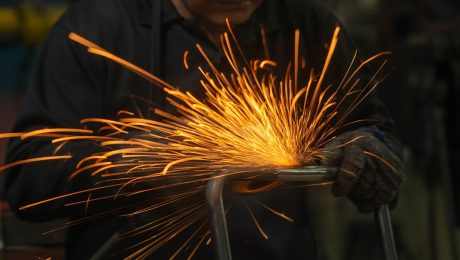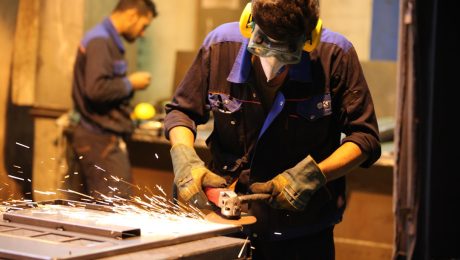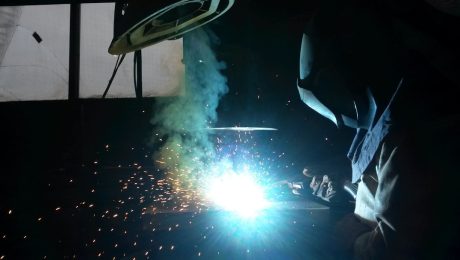Hot rolled flat bars are a ubiquitous material in various industries, providing a robust and versatile solution for a wide range of applications. Understanding their properties and manufacturing process is crucial for selecting the right material for your specific needs. This comprehensive guide will delve into the intricacies of hot rolled flat bars, providing a detailed overview of their characteristics and uses.
The Manufacturing Process of Hot Rolled Flat Bars
The creation of hot rolled flat bars begins with the heating of steel to a high temperature, typically above its recrystallization temperature. This elevated temperature significantly reduces the steel’s yield strength, making it malleable and easily shaped. The heated steel is then passed through a series of rollers, progressively reducing its thickness and shaping it into a flat bar. This process, known as hot rolling, imparts several key characteristics to the final product. The high temperature allows for significant deformation without fracturing, leading to a more efficient and cost-effective process compared to cold rolling. The final dimensions are achieved through carefully controlled passes through the rolling mill. After rolling, the bars undergo a controlled cooling process, which influences their final microstructure and properties. The entire process is a continuous flow, from the initial heating to the final cutting and stacking of the finished product.
Mechanical Properties and Composition of Hot Rolled Flat Bars
The mechanical properties of hot rolled flat bars are largely determined by the steel grade used. Common steel grades include mild steel, medium carbon steel, and high carbon steel, each possessing different strength, ductility, and hardness characteristics. Mild steel, for instance, offers good weldability and formability, making it suitable for applications where ease of fabrication is paramount. Medium carbon steel provides a balance between strength and ductility, while high carbon steel offers superior strength but reduced ductility. The chemical composition of the steel, including the precise ratios of carbon, manganese, silicon, and other alloying elements, significantly impacts the final properties. These properties are crucial for determining the suitability of the bar for a particular application. Detailed specifications, often provided by the manufacturer, describe the exact chemical composition and mechanical properties of each batch of hot rolled flat bars.
Common Applications of Hot Rolled Flat Bars
The versatility of hot rolled flat bars makes them suitable for a wide array of applications across diverse industries. In construction, they are used as reinforcement bars in concrete structures, providing tensile strength and stability. In the manufacturing sector, they serve as raw material for the production of various components, including machinery parts, automotive parts, and structural elements. They are also commonly used in the fabrication of railings, fences, and other structural elements. The specific application depends heavily on the chosen steel grade and the required mechanical properties. For example, high-strength steel bars are preferred in applications requiring high load-bearing capacity, while mild steel bars are suitable for applications where weldability and formability are crucial.
Advantages and Disadvantages of Hot Rolled Flat Bars
Hot rolled flat bars offer several advantages, including their cost-effectiveness compared to cold-rolled counterparts. The high-temperature processing allows for higher production rates and lower energy consumption. They also exhibit good strength and toughness, making them suitable for various applications. However, they also have some disadvantages. Their surface finish is generally rougher than cold-rolled bars, which may require further processing for specific applications. The higher temperature processing can also lead to some dimensional inconsistencies compared to cold-rolled bars. These factors should be considered when selecting the appropriate material for a given project. The precise advantages and disadvantages need to be weighed against the specific requirements of the application.
Selecting the Right Hot Rolled Flat Bar: A Guide to Specifications
Choosing the correct hot rolled flat bar requires careful consideration of several factors. Firstly, the required mechanical properties, such as tensile strength, yield strength, and elongation, must be carefully evaluated based on the application. Secondly, the desired dimensions, including thickness, width, and length, are crucial for proper fit and function. Thirdly, the surface finish requirements should be determined, as this can influence the need for further processing. Finally, the steel grade should be selected based on the desired balance of strength, ductility, weldability, and cost. Understanding these specifications is essential for selecting the optimal hot rolled flat bar for a particular application and ensuring its successful implementation.
Understanding the nuances of hot rolled flat bars is essential for engineers, fabricators, and anyone involved in material selection. This detailed guide provides a comprehensive overview of their properties, manufacturing, and applications, empowering you to make informed decisions for your projects.
body {
font-family: sans-serif;
line-height: 1.6;
}
h1, h2, h3 {
color: #333;
}
The safe and efficient transportation of natural gas relies heavily on the integrity of the pipeline infrastructure. Corrosion is a significant threat, leading to leaks, environmental damage, and potential safety hazards. To combat this, various protective coatings are employed, with EP (Epoxy), PP (Polypropylene), and PE (Polyethylene) coated pipes emerging as leading solutions. This comprehensive guide delves into the specifics of these coatings, their applications, and their crucial role in ensuring the longevity and safety of gas pipelines.
Understanding EP, PP, and PE Coatings for Gas Pipelines
Each coating offers unique properties tailored to specific pipeline environments and operational demands. Epoxy (EP) coatings are thermosetting polymers known for their excellent adhesion, chemical resistance, and mechanical strength. They provide a robust barrier against corrosion, particularly in aggressive soil conditions. Polypropylene (PP) coatings, on the other hand, are thermoplastic polymers offering high impact resistance and flexibility, making them ideal for pipelines subjected to significant mechanical stress. Polyethylene (PE) coatings, also thermoplastic, are renowned for their excellent abrasion resistance, ease of application, and cost-effectiveness. The choice of coating depends on factors like pipeline diameter, soil conditions, operating pressure, and budget constraints.
Advantages of Using EP/PP/PE Coated Pipes in Gas Transmission
The use of EP, PP, and PE coated pipes offers several significant advantages in gas pipeline construction and operation. These include:
- Enhanced Corrosion Protection: The coatings act as a barrier, preventing moisture and corrosive agents from reaching the pipe’s surface, significantly extending its lifespan.
- Improved Safety: By preventing corrosion-related failures, coated pipes minimize the risk of leaks and explosions, enhancing the overall safety of the gas transportation system.
- Reduced Maintenance Costs: The extended lifespan and reduced risk of failures translate into lower maintenance and repair expenses over the pipeline’s operational life.
- Ease of Installation: Many PE coatings, in particular, are relatively easy to apply and handle, streamlining the installation process.
- Environmental Benefits: By preventing leaks and reducing the need for repairs, coated pipes contribute to environmental protection by minimizing the release of greenhouse gases and other pollutants.
Factors Influencing the Selection of Coating Type for Gas Pipelines
Choosing the appropriate coating for a gas pipeline project requires careful consideration of several key factors:
- Soil Conditions: Aggressive soils with high acidity or salinity require coatings with superior chemical resistance, often favoring EP coatings.
- Pipeline Diameter and Length: Larger diameter pipes may require specific application techniques and coating thicknesses.
- Operating Pressure: High-pressure pipelines necessitate coatings with exceptional mechanical strength to withstand the internal stress.
- Environmental Regulations: Compliance with local and national environmental regulations is crucial in selecting appropriate coatings and application methods.
- Budgetary Constraints: Cost-effectiveness plays a significant role, with PE coatings often presenting a more economical option compared to EP coatings.
Installation and Quality Control of EP/PP/PE Coated Pipes
Proper installation and quality control are vital to ensuring the effectiveness of the coating. This includes meticulous surface preparation of the pipe before coating application, adherence to strict application procedures to ensure uniform coating thickness and absence of defects, and thorough inspection to identify and rectify any imperfections. Regular inspections throughout the pipeline’s lifespan are also crucial to detect any signs of coating degradation or damage.
Advanced non-destructive testing (NDT) methods, such as ultrasonic testing and electromagnetic inspection, are often employed to assess the integrity of the coating and the underlying pipe material. These techniques help identify potential flaws and ensure the continued safety and reliability of the gas pipeline.
Regulations and Standards for Coated Gas Pipelines
The design, construction, and operation of gas pipelines are subject to stringent regulations and standards to ensure public safety and environmental protection. These regulations often specify requirements for coating materials, application methods, inspection procedures, and testing protocols. Compliance with these standards is essential to obtain necessary permits and approvals for pipeline projects. Organizations such as the American Gas Association (AGA), ISO, and national regulatory bodies play a crucial role in establishing and enforcing these standards. Staying updated on these regulations is crucial for anyone involved in the gas pipeline industry.
In conclusion, the selection and proper application of EP, PP, and PE coated pipes are crucial for the long-term integrity, safety, and efficiency of gas pipeline systems. Careful consideration of various factors, adherence to industry standards, and rigorous quality control are paramount to ensuring the successful implementation of these crucial protective measures.
SEO Tags:
- EP coated pipes
- PP coated pipes
- PE coated pipes
- Gas pipeline coatings
- Corrosion protection pipelines
body { font-family: sans-serif; line-height: 1.6; }
h1, h2, h3 { color: #333; }
img { max-width: 100%; height: auto; }
In the world of industrial design, structural integrity is paramount. The choice of materials and components directly impacts the safety, longevity, and overall functionality of any project. Among the many structural elements available, IPN beams stand out for their exceptional strength-to-weight ratio and versatility, making them a preferred choice for a wide range of industrial applications.
Understanding IPN Beams: A Deeper Dive into Their Characteristics
IPN beams, also known as parallel flange I-beams, are hot-rolled steel sections characterized by their parallel flanges and a relatively deep web. This unique design contributes to their high bending resistance and exceptional load-bearing capacity. Unlike other I-beams with tapered flanges, IPN beams offer a more consistent structural performance, simplifying calculations and design processes. Their parallel flanges also make them easier to weld and connect to other structural elements, further enhancing their practicality in industrial settings.
The precise dimensions and properties of IPN beams vary depending on their size designation. These dimensions are standardized, allowing for easy selection and accurate calculation of load-bearing capabilities. Detailed specifications can be found in relevant steel construction manuals and online databases.
Applications of IPN Beams in Diverse Industrial Settings
The versatility of IPN beams makes them suitable for a wide spectrum of industrial applications. Their robust construction and efficient design make them ideal for:
- Heavy-duty shelving and racking systems: IPN beams provide the necessary strength to support heavy loads in warehouses and distribution centers.
- Structural support in factories and workshops: They are used to create robust frameworks for machinery, conveyors, and other industrial equipment.
- Bridge construction and infrastructure projects: Their high strength-to-weight ratio contributes to efficient bridge design and construction.
- Construction of industrial buildings: IPN beams form the backbone of many industrial structures, providing essential support for roofs, walls, and floors.
- Offshore platforms and marine structures: Their corrosion resistance (when properly treated) makes them suitable for demanding marine environments.
Advantages of Choosing IPN Beams for Industrial Projects
The decision to utilize IPN beams in industrial design is driven by several key advantages:
- High strength-to-weight ratio: This allows for lighter structures without compromising strength, leading to cost savings in materials and transportation.
- Ease of fabrication and assembly: The parallel flanges simplify welding and bolting, reducing construction time and labor costs.
- Cost-effectiveness: While the initial cost might be slightly higher than some other options, the long-term benefits of durability and reduced maintenance outweigh the initial investment.
- Improved design flexibility: Their consistent geometry simplifies structural calculations and allows for more creative design solutions.
- Enhanced structural stability: The deep web and parallel flanges provide exceptional resistance to bending and deflection, ensuring long-term stability of the structure.
Design Considerations and Best Practices for IPN Beam Integration
While IPN beams offer numerous advantages, careful consideration should be given to several factors during the design phase:
- Load calculations: Accurate load calculations are essential to ensure the selected IPN beam size can handle the anticipated stresses.
- Support conditions: The type and spacing of supports significantly impact the beam’s performance. Proper support design is crucial for optimal load distribution.
- Corrosion protection: In harsh environments, appropriate corrosion protection measures, such as galvanizing or painting, are necessary to extend the lifespan of the beams.
- Connection details: Careful attention should be paid to the design of connections between IPN beams and other structural elements to ensure adequate strength and stability.
- Compliance with building codes and standards: All designs must adhere to relevant building codes and standards to ensure safety and compliance.
Overcoming Challenges and Future Trends in IPN Beam Usage
While IPN beams are highly versatile, certain challenges remain. One key aspect is the need for accurate load estimations. Underestimating the load can lead to structural failure, while overestimating can lead to unnecessary material costs. Advancements in finite element analysis (FEA) software are helping engineers better predict and manage these loads. Furthermore, the development of high-strength steels is leading to even lighter and stronger IPN beams, further enhancing their efficiency and applications in increasingly complex industrial designs. The future of IPN beam usage lies in integrating these advancements with sustainable design practices, contributing to more environmentally friendly and economically viable industrial constructions.
In conclusion, IPN beams represent a significant advancement in structural engineering, offering a compelling blend of strength, efficiency, and versatility. By carefully considering the design aspects and leveraging the latest advancements in material science and engineering software, designers can harness the full potential of IPN beams to create robust, reliable, and cost-effective industrial structures.
Steel, a ubiquitous material in modern construction, demands specialized knowledge for safe and efficient utilization. This comprehensive guide delves into the crucial aspects of steel training for civil engineers, equipping you with the understanding necessary for successful project delivery.
Understanding Steel Material Properties
A foundational element of steel training involves a deep understanding of the material’s properties. This goes beyond simply knowing it’s strong. Civil engineers need to grasp the nuances of different steel grades (e.g., A36, A992, A572), their yield strengths, tensile strengths, and ductility. They must also understand the impact of factors like temperature, corrosion, and welding on these properties. Knowledge of material testing methods, such as tensile testing and impact testing, is crucial for quality control and ensuring the structural integrity of the steel used in projects. Furthermore, understanding the behavior of steel under various loading conditions, including static and dynamic loads, is paramount for accurate design calculations.
Mastering Steel Design Principles
Effective steel design involves applying established codes and standards, such as the American Institute of Steel Construction (AISC) manual and Eurocodes, to ensure structural safety and compliance. Civil engineers require proficiency in analyzing forces and stresses within steel structures using methods like the elastic method, plastic method, and finite element analysis (FEA). This includes designing connections, which are critical points in steel structures where failure is most likely to occur. Understanding different connection types, such as bolted, welded, and riveted connections, and their respective strengths and limitations, is essential. Moreover, engineers must be adept at detailing these connections, ensuring accurate fabrication and assembly on-site. Proper detailing is crucial to avoid costly errors during construction.
Advanced Steel Construction Techniques
Steel construction is far from a simple process; it’s a complex interplay of skilled labor and precise engineering. Training in this area encompasses understanding various construction methods, including erection techniques for different steel members (beams, columns, trusses), the use of specialized equipment (cranes, lifting gear), and safety protocols related to high-altitude work and heavy machinery. Furthermore, it involves familiarity with different welding techniques (e.g., SMAW, GMAW, FCAW), their implications for weld quality and strength, and non-destructive testing (NDT) methods used to ensure weld integrity. Understanding bolt tightening procedures and the importance of proper torque control is also vital to prevent premature failure of bolted connections. Finally, familiarity with modern construction management techniques, including lean construction principles, is crucial for efficient project delivery.
Utilizing Steel Design Software
Modern steel design relies heavily on specialized software. Proficiency in programs like RISA-3D, Tekla Structures, and AutoCAD is essential for efficient analysis and detailing. These programs allow engineers to model complex steel structures, perform structural analysis, and generate detailed fabrication drawings. Training should cover not only the basic operation of these software packages but also the interpretation of results, understanding limitations, and ensuring accurate model representation of the real-world structure. Understanding the intricacies of inputting material properties, boundary conditions, and load cases is crucial to obtaining reliable results. Moreover, effective use of these programs significantly reduces design time and improves accuracy compared to manual calculations.
Staying Updated with Industry Standards and Best Practices
The field of steel construction is constantly evolving, with new materials, techniques, and software emerging regularly. Continuous professional development is crucial for civil engineers working with steel. This involves staying abreast of updated codes and standards, attending industry conferences and workshops, and participating in continuing education programs. Understanding the latest research on steel behavior and innovative construction methods is essential for designing safe, efficient, and sustainable steel structures. Furthermore, networking with other professionals in the field can provide valuable insights and best practices for improving design and construction processes. Active participation in professional organizations, such as the AISC, can provide access to valuable resources and networking opportunities.
In conclusion, comprehensive steel training for civil engineers is a multifaceted endeavor requiring a solid understanding of material properties, design principles, construction techniques, software proficiency, and a commitment to continuous learning. By mastering these aspects, civil engineers can successfully design and oversee the construction of safe, efficient, and sustainable steel structures.
SEO Tags:
- Steel Training Civil Engineers
- Steel Structures Design
- Steel Construction Techniques
- Structural Steel Analysis Software
- AISC Steel Design Manual
body { font-family: sans-serif; line-height: 1.6; }
h1, h2, h3 { color: #333; }
code { background-color: #f0f0f0; padding: 2px 4px; border-radius: 4px; }
Steel is a ubiquitous material in modern civil engineering, forming the backbone of countless structures from skyscrapers to bridges. A strong understanding of steel design, fabrication, and construction is therefore crucial for any aspiring or practicing civil engineer. This comprehensive guide explores the essential aspects of steel training, equipping you with the knowledge to excel in this critical area.
Understanding Steel Properties and Design Principles
Before diving into design, a solid grasp of steel’s mechanical properties is essential. This includes understanding yield strength, tensile strength, ultimate strength, and ductility. Civil engineers need to be proficient in using relevant codes and standards, such as AISC (American Institute of Steel Construction) or Eurocode 3, to determine allowable stresses and design factors. This section covers the fundamental concepts of stress-strain relationships, buckling behavior, and the influence of different steel grades on structural performance. Learning to interpret material test reports and understand the implications of material variations is also critical. Furthermore, understanding the concept of limit states design – ensuring a structure’s safety under various loading conditions – is paramount. This section also delves into the use of design charts and tables provided in relevant design codes to simplify calculations and ensure compliance with regulations.
Steel Fabrication and Construction Techniques
Theoretical design is only half the battle. Civil engineers must also understand the practical aspects of steel fabrication and construction. This includes familiarity with various steel sections (e.g., I-beams, channels, angles), connection methods (bolting, welding), and the importance of proper detailing for efficient and safe construction. Understanding the processes involved in steel fabrication, from cutting and shaping to surface treatment, is vital for effective project management and quality control. This section also explores different welding techniques, their advantages and limitations, and the importance of weld inspection. Additionally, the safe handling and erection of steel members on site, including the use of appropriate lifting equipment and safety protocols, is covered. A thorough understanding of the tolerances allowed during fabrication and construction is also crucial for ensuring the structural integrity of the final product.
Advanced Steel Design Software and Analysis
Modern steel design relies heavily on sophisticated software packages. Proficiency in at least one leading software, such as ETABS, SAP2000, or RISA-3D, is practically essential for any practicing civil engineer. This section focuses on the application of these programs for analysis and design of steel structures. It covers topics such as modeling techniques, load application, analysis methods (linear and non-linear), and interpretation of results. Understanding the limitations of software and the importance of independent verification of results is also crucial. The ability to create detailed design drawings and specifications using these software packages is also a key skill. This involves understanding how to generate shop drawings, connection details, and other necessary documentation for fabrication and construction.
Case Studies and Real-World Applications
To solidify understanding, the application of steel design principles to real-world scenarios is essential. This section presents several case studies of diverse steel structures, from simple beams to complex high-rise buildings and bridges. Each case study will illustrate the design process, highlighting the challenges encountered and the solutions implemented. Analyzing successful projects helps engineers learn from best practices, while examining failures can provide invaluable lessons on avoiding common pitfalls. This section also explores the sustainable aspects of steel design, including the use of recycled steel and the minimization of environmental impact. Finally, the importance of considering factors like fire protection and corrosion prevention in steel structures is addressed.
Continuing Professional Development in Steel Design
The field of steel design is constantly evolving, with new materials, techniques, and software emerging regularly. Continuous professional development is therefore crucial for staying ahead of the curve. This section explores various avenues for continuing education, such as attending workshops, conferences, and online courses. Keeping up-to-date with the latest codes, standards, and research is also essential. Joining professional organizations like the AISC or similar international bodies provides access to valuable resources and networking opportunities. Furthermore, actively participating in industry projects and seeking mentorship from experienced professionals can significantly enhance skill development and career progression. This section concludes with a discussion of the importance of obtaining relevant certifications to demonstrate competence and professionalism in the field.
Mastering steel design is a journey, but one that is incredibly rewarding for civil engineers. By focusing on the fundamental principles, practical applications, and continuous learning, you can build a strong foundation for a successful and impactful career in this dynamic field.
Tags: Steel Design, Civil Engineering, Steel Structures, AISC, Structural Analysis, Steel Fabrication
In the world of construction and manufacturing, steel is a cornerstone material. Its strength, durability, and versatility make it indispensable across numerous industries. However, ensuring the quality and safety of steel products is paramount. This is where CE certification comes in, providing a crucial mark of assurance for both manufacturers and consumers.
Understanding CE Certification for Steel
The CE marking (Conformité Européenne) is a mandatory conformity marking for products sold within the European Economic Area (EEA). It indicates that a product meets the essential requirements of relevant European Union (EU) health, safety, and environmental protection legislation. For steel products, this means that they have been tested and verified to comply with harmonized European standards (EN standards) relevant to their specific application. The CE mark isn’t a quality mark in itself; rather, it’s a declaration by the manufacturer that their product conforms to the essential requirements of the applicable directives. This declaration is backed by a comprehensive assessment process, often involving third-party conformity assessment bodies.
Key European Standards for CE-Certified Steel
The specific EN standards a steel product must meet depend on its intended use. For instance, structural steel used in construction will be subject to different standards than steel used in automotive manufacturing. Some commonly referenced EN standards for steel include:
- EN 10025: This standard covers hot-rolled products of structural steels.
- EN 10210: This standard covers seamless steel tubes for pressure purposes.
- EN 10305-1: This standard covers cold-formed welded structural hollow sections.
- EN 1090: This is a crucial standard concerning execution of steel structures. It covers the fabrication and assessment of structural steel components.
Compliance with these standards is rigorously tested and verified throughout the manufacturing process, ensuring consistent quality and safety.
Verification and Testing Procedures for CE-Certified Steel
The process of obtaining CE certification for steel products is not a simple matter of self-declaration. It involves a multi-stage process that includes:
- Design and Manufacturing Process Assessment: The manufacturer’s production process is evaluated to ensure it consistently produces steel meeting the relevant EN standards.
- Material Testing: Rigorous testing is conducted on the steel itself to verify its mechanical properties, chemical composition, and other relevant characteristics.
- Product Testing: Depending on the product type, specific tests might be carried out to evaluate its performance under various conditions, such as tensile strength, yield strength, and impact resistance.
- Third-Party Conformity Assessment: A Notified Body, a third-party organization accredited by the EU, often plays a key role in verifying the manufacturer’s compliance with the relevant standards. This could involve factory inspections, sampling tests, and review of the manufacturer’s quality control system.
- Declaration of Conformity: Once all requirements are met, the manufacturer issues a Declaration of Conformity, affirming that the product complies with the applicable directives and standards. This declaration is crucial evidence for demonstrating compliance.
Applications of CE-Certified Steel Products
The wide range of applications for CE-certified steel highlights its importance across various sectors. These include:
- Construction: From skyscrapers to bridges and residential buildings, CE-certified steel is crucial for ensuring structural integrity and safety.
- Automotive Industry: Steel forms the backbone of many vehicles, and CE certification ensures the safety and reliability of these components.
- Manufacturing: Various industrial machinery and equipment utilize steel components, where CE certification guarantees compliance with safety regulations.
- Infrastructure Projects: Large-scale projects like railways, pipelines, and energy infrastructure rely heavily on CE-certified steel.
- Renewable Energy: Wind turbines and solar panel structures utilize high-strength steel, and CE certification is crucial for their long-term performance and safety.
Benefits of Using CE-Certified Steel Products
Choosing CE-certified steel products offers several significant advantages:
- Enhanced Safety: The rigorous testing and verification process ensures that the steel meets the highest safety standards, minimizing risks of accidents or structural failures.
- Improved Quality: CE certification guarantees consistent quality, ensuring reliable performance and longevity of the steel products.
- Legal Compliance: Using CE-certified steel ensures compliance with EU regulations, avoiding potential legal issues and penalties.
- Increased Trust and Confidence: The CE mark provides reassurance to customers, architects, engineers, and contractors, fostering trust in the quality and safety of the products.
- Facilitated Trade: CE certification simplifies the process of importing and exporting steel products within the EEA, reducing bureaucratic hurdles.
In conclusion, CE certification is not merely a label; it’s a testament to the quality, safety, and reliability of steel products. By choosing CE-certified steel, businesses and individuals alike can ensure they are using materials that meet the highest standards of performance and compliance, contributing to safer and more sustainable projects.
Tags: CE certification, steel products, steel safety, European standards, EN standards
body { font-family: sans-serif; line-height: 1.6; }
h1, h2, h3 { color: #333; }
img { max-width: 100%; height: auto; }
Hexagonal steel bars, often overlooked in favor of their round counterparts, offer a unique set of properties and applications. This comprehensive guide will explore the world of hexagonal steel, delving into their characteristics, uses, manufacturing processes, and the advantages they provide over other steel bar shapes.
The Unique Properties of Hexagonal Steel Bars
Hexagonal steel bars possess several key properties that distinguish them from round or square bars. Their six-sided shape provides increased surface area compared to a round bar of the same cross-sectional area. This larger surface area can be advantageous in applications requiring greater grip or frictional resistance. Furthermore, the hexagonal shape offers superior resistance to bending and twisting compared to a square bar of equivalent weight, due to its more efficient distribution of material. The precise angles of the hex also lend themselves to specific joining and assembly techniques. The strength properties are largely determined by the grade of steel used, with common grades including mild steel, medium carbon steel, and high-carbon steel, each offering varying levels of tensile strength, yield strength, and hardness.
Manufacturing Processes: From Ingot to Hexagon
The creation of hexagonal steel bars involves a series of precise manufacturing processes. It typically begins with the melting of steel scrap or raw materials in a furnace to produce an ingot. This ingot is then rolled into a billet, a semi-finished product with a square or rectangular cross-section. The crucial step is the hot rolling process where the billet is passed through a series of progressively smaller hexagonal dies. This process carefully shapes the billet into the desired hexagonal profile while simultaneously reducing its size and increasing its strength. After hot rolling, the bars undergo a cooling process, often followed by straightening and cutting to precise lengths. Quality control measures, including dimensional checks and strength testing, ensure the final product meets stringent specifications.
Diverse Applications Across Industries
The versatility of hexagonal steel bars makes them suitable for a wide range of applications across various industries. In the construction industry, they are frequently used as reinforcement bars in concrete structures, offering superior grip and load-bearing capacity. Their high strength-to-weight ratio makes them ideal for applications where weight minimization is crucial, such as in aerospace and automotive components. They are also commonly used in the manufacturing of handrails, railings, and other architectural elements, providing both strength and an aesthetically pleasing finish. Furthermore, hexagonal steel bars find applications in mechanical engineering, as shafts, axles, and components in machinery, leveraging their superior resistance to torsion.
Advantages of Choosing Hexagonal Steel Over Other Shapes
Compared to round or square steel bars, hexagons offer several distinct advantages. As mentioned, their increased surface area enhances grip and frictional properties, crucial in applications requiring secure fastening or anti-slip features. Their superior resistance to bending and twisting makes them ideal for applications under significant stress. The hexagonal shape also facilitates easier handling and stacking compared to round bars, leading to improved efficiency in storage and transportation. Finally, the unique geometry of hexagonal bars can be aesthetically pleasing, making them a preferred choice in architectural and decorative applications.
Common Misconceptions and Considerations
Despite their numerous advantages, some misconceptions surround hexagonal steel bars. One common misconception is that they are significantly more expensive than round bars. While the manufacturing process might be slightly more complex, the cost difference is often negligible, particularly when considering the enhanced performance and advantages they offer. Another consideration is the selection of the appropriate steel grade based on the specific application requirements. Choosing the wrong grade can compromise the structural integrity and longevity of the project. Finally, careful consideration should be given to the surface finish and any potential need for further treatment, such as galvanization or painting, to protect against corrosion.
Hexagonal steel bars represent a robust and versatile material with a wide range of applications. Understanding their unique properties and manufacturing process is crucial for engineers, designers, and anyone involved in selecting materials for construction, manufacturing, or other industrial projects.
SEO-Friendly Tags:
- Hexagonal steel bars
- Steel bar shapes
- Hexagonal steel properties
- Steel bar applications
- Hexagon steel manufacturing
body { font-family: sans-serif; line-height: 1.6; }
h1, h2, h3 { color: #333; }
img { max-width: 100%; height: auto; }
Wind turbines, majestic symbols of renewable energy, rely on a complex interplay of components to harness the power of the wind. While the blades themselves capture the wind’s energy, their efficient and safe operation hinges on a robust and reliable support system. This system, often overlooked, is crucial for the turbine’s longevity, performance, and safety. This blog post delves into the intricate world of wind turbine blade support systems, exploring their various aspects and future advancements.
1. The Anatomy of a Wind Turbine Blade Support System
A wind turbine blade support system is far more than just a simple connection. It’s a sophisticated engineering marvel designed to withstand immense forces, both static and dynamic. The system typically includes several key components: the blade root, the pitch bearing, the main bearing, and the nacelle structure. The blade root is the critical interface between the blade and the rest of the turbine. It’s designed to transfer the aerodynamic loads generated by the rotating blade to the hub and ultimately to the tower. The pitch bearing allows for the adjustment of the blade angle (pitch control), crucial for optimizing energy capture and protecting the turbine during high winds. The main bearing supports the entire rotating assembly, including the hub, blades, and gearbox, while the nacelle structure houses these components and provides further structural support.
The materials used in these components are critical to their performance. High-strength steel alloys, composites like carbon fiber reinforced polymers (CFRP), and advanced polymers are commonly employed to balance strength, weight, and fatigue resistance. The design must account for factors like centrifugal forces, wind loads, and thermal stresses, demanding precise calculations and rigorous testing.
2. Material Selection and its Impact on Performance
The choice of materials significantly impacts the performance and lifespan of the blade support system. Traditional steel has been widely used due to its strength and well-understood properties. However, the increasing demand for larger and more efficient turbines has led to the incorporation of lighter yet equally strong materials. CFRP, for example, offers a superior strength-to-weight ratio, allowing for larger blades that can capture more energy while reducing the overall stress on the support system. This results in improved efficiency and reduced wear and tear.
However, the use of composites presents its own set of challenges. Their manufacturing process is more complex and expensive, and their long-term behavior under cyclic loading requires careful consideration. Ongoing research focuses on developing advanced composite materials with enhanced durability and resistance to fatigue and environmental degradation.
3. Maintenance and Inspection of Blade Support Systems
Regular maintenance and inspection are paramount to ensuring the reliable operation of wind turbine blade support systems. These systems are subjected to harsh environmental conditions, including extreme temperatures, high winds, and exposure to moisture and salt spray. This can lead to corrosion, fatigue, and material degradation, potentially causing catastrophic failure. Therefore, a comprehensive maintenance program is essential.
Inspections typically involve visual checks for signs of damage, wear, or corrosion, as well as non-destructive testing methods such as ultrasonic inspection and radiography to detect internal flaws. Regular lubrication of bearings and other moving parts is crucial to minimize friction and wear. Predictive maintenance techniques, utilizing sensors and data analytics, are becoming increasingly important to optimize maintenance schedules and prevent unexpected failures.
4. Advanced Technologies and Future Innovations
The field of wind turbine blade support systems is constantly evolving. Researchers are exploring new materials and designs to enhance performance, reliability, and cost-effectiveness. Advanced materials like graphene-enhanced composites and self-healing materials hold the potential to significantly improve the durability and lifespan of these systems. Furthermore, innovative manufacturing techniques, such as additive manufacturing (3D printing), are being investigated to produce customized components with complex geometries and optimized performance.
The integration of smart sensors and advanced monitoring systems allows for real-time monitoring of the blade support system’s health and performance. This data can be used to predict potential failures, optimize maintenance schedules, and improve the overall efficiency of the wind turbine.
5. The Role of Blade Support Systems in Turbine Safety
The safety implications of a malfunctioning blade support system are significant. A failure can lead to blade damage, structural failure of the nacelle, and even catastrophic turbine collapse. This poses a serious risk to personnel, property, and the environment. Therefore, the design, manufacturing, and maintenance of these systems are subject to stringent safety regulations and standards. Redundancy and fail-safe mechanisms are often incorporated into the design to mitigate the risk of failure.
Ongoing research and development efforts focus on enhancing the safety and reliability of blade support systems. This includes improved design methodologies, advanced materials, and robust monitoring systems to detect and prevent potential failures before they can occur. The safety of these systems is paramount in ensuring the continued growth and acceptance of wind energy as a clean and sustainable source of power.
In conclusion, wind turbine blade support systems are critical components that ensure the efficient, safe, and reliable operation of wind turbines. Their design, material selection, maintenance, and ongoing innovation are crucial for the future of wind energy.
Tags: Wind Turbine, Blade Support System, Wind Energy, Renewable Energy, Turbine Maintenance
In today’s rapidly evolving business landscape, stagnation is a death sentence. Organizations that thrive are those that embrace a culture of continuous improvement – a commitment to constantly seeking better ways of doing things. This isn’t just about incremental changes; it’s about fostering a mindset where improvement is ingrained in every aspect of the organization, from the top down.
Understanding the Foundation: What is Continuous Improvement?
Continuous improvement, often referred to as Kaizen (a Japanese term meaning “change for the better”), is a philosophy that emphasizes ongoing incremental improvements to processes, products, and services. It’s not about revolutionary overhauls, but rather a series of small, manageable changes that accumulate to create significant positive impact over time. This approach encourages everyone within the organization to identify areas for improvement and contribute to solutions. It’s about proactively identifying inefficiencies, reducing waste, and enhancing quality – not just reacting to problems after they arise.
Building the Pillars: Key Elements of a Continuous Improvement Culture
Creating a successful continuous improvement culture requires a multi-faceted approach. Several key elements must be in place to support and sustain this ongoing effort. These include:
- Leadership Commitment: Top-level management must champion the initiative, actively participating and demonstrating a commitment to change. This sets the tone for the entire organization and ensures resources are allocated appropriately.
- Employee Empowerment: Empowering employees to identify and suggest improvements is crucial. This requires creating a safe space where individuals feel comfortable sharing ideas without fear of retribution. Providing training and resources to support their efforts is also essential.
- Data-Driven Decision Making: Continuous improvement relies on data to identify areas for improvement and measure the impact of implemented changes. Establishing clear metrics and tracking progress are vital to demonstrate success and guide future improvements.
- Open Communication and Collaboration: Effective communication is key to sharing ideas, feedback, and best practices across teams and departments. Collaboration fosters a sense of shared ownership and accountability for improvement efforts.
- Regular Feedback and Recognition: Regular feedback loops ensure that improvements are consistently evaluated and adjusted as needed. Recognizing and rewarding contributions to continuous improvement reinforces positive behavior and motivates further engagement.
Implementing the Strategy: Practical Steps for Cultivating Kaizen
Implementing a continuous improvement culture requires a strategic approach. Here are some practical steps organizations can take:
- Define Clear Goals and Objectives: Establish specific, measurable, achievable, relevant, and time-bound (SMART) goals for improvement. This provides a clear direction and helps track progress.
- Identify Key Processes for Improvement: Focus on processes that have the greatest impact on efficiency, quality, or customer satisfaction. Use tools like process mapping to visualize and analyze these processes.
- Implement Improvement Tools and Techniques: Utilize various tools such as Lean methodologies, Six Sigma, 5S, and Kaizen events to systematically identify and address areas for improvement.
- Train Employees on Continuous Improvement Principles: Provide training to equip employees with the knowledge and skills necessary to participate effectively in improvement initiatives.
- Establish a Feedback Mechanism: Create a system for collecting and analyzing feedback from employees, customers, and other stakeholders. This provides valuable insights into areas for improvement.
- Regularly Review and Adjust: Continuously monitor and evaluate the effectiveness of implemented improvements, making adjustments as needed to ensure ongoing progress.
Measuring Success: Tracking Progress and Demonstrating ROI
Measuring the success of a continuous improvement culture is essential to demonstrate its value and sustain momentum. Key performance indicators (KPIs) should be established to track progress against defined goals. These might include:
- Reduced waste and defects: Tracking reductions in material waste, production errors, or customer complaints.
- Improved efficiency and productivity: Measuring increases in output, reduced cycle times, or improved resource utilization.
- Enhanced customer satisfaction: Monitoring customer feedback and satisfaction scores.
- Increased employee engagement: Measuring employee morale, participation in improvement initiatives, and suggestions for improvement.
- Cost savings: Tracking reductions in operational costs resulting from improved efficiency and reduced waste.
By regularly monitoring these KPIs, organizations can demonstrate the tangible return on investment (ROI) of their continuous improvement efforts and showcase the value of this culture to stakeholders.
Overcoming Challenges: Addressing Common Obstacles
Implementing a culture of continuous improvement is not without its challenges. Common obstacles include resistance to change, lack of resources, insufficient training, and poor communication. To overcome these challenges, organizations need to:
- Address resistance to change proactively: Communicate the benefits of continuous improvement clearly and address concerns transparently. Involve employees in the process to foster buy-in.
- Secure adequate resources: Allocate sufficient time, budget, and personnel to support improvement initiatives.
- Provide comprehensive training: Equip employees with the necessary skills and knowledge to participate effectively.
- Foster open and transparent communication: Ensure regular communication and feedback loops to keep everyone informed and engaged.
- Celebrate successes and learn from failures: Recognize achievements to reinforce positive behavior and analyze failures to identify lessons learned.
By proactively addressing these challenges, organizations can create a sustainable culture of continuous improvement that drives long-term success.
In conclusion, cultivating a culture of continuous improvement is a journey, not a destination. It requires consistent effort, commitment, and a willingness to adapt and evolve. By embracing the principles of Kaizen and implementing the strategies outlined above, organizations can unlock their full potential and achieve sustainable growth in an ever-changing world.
Tags: Continuous Improvement, Kaizen, Lean Management, Six Sigma, Process Improvement
body {
font-family: sans-serif;
line-height: 1.6;
}
h1, h2, h3 {
color: #333;
}
The steel industry is a significant contributor to global greenhouse gas emissions. Accurate and transparent carbon emission reporting is crucial for driving decarbonization efforts and meeting increasingly stringent environmental regulations. This comprehensive guide explores the complexities of reporting carbon emissions within the steel sector, providing a clear understanding of the processes involved.
Understanding the Scope of Steel Emissions: Scope 1, 2, and 3
Reporting carbon emissions in the steel industry requires understanding the Greenhouse Gas (GHG) Protocol’s three scopes:
- Scope 1: Direct Emissions: These are emissions produced directly from owned or controlled sources. In steel production, this includes emissions from coke ovens, blast furnaces, and other direct combustion processes within the steel plant. Accurate measurement requires meticulous monitoring of fuel consumption, process efficiency, and fugitive emissions (e.g., leaks from pipelines).
- Scope 2: Indirect Emissions from Energy Consumption: These emissions arise from the generation of purchased electricity, heat, or steam used in steel production. Reporting requires obtaining data from energy suppliers on the carbon intensity of their electricity generation. This often involves using emission factors provided by national or regional grid operators.
- Scope 3: Indirect Emissions from the Value Chain: This is the most complex scope, encompassing emissions from sources not owned or controlled by the steel producer but related to its operations. This includes emissions from:
- Upstream Activities: Raw material extraction (iron ore, coal, etc.), transportation of raw materials, and the manufacturing of purchased goods and services.
- Downstream Activities: Transportation of finished steel products, use of steel products by customers, and end-of-life management of steel products.
Accurate Scope 3 reporting requires extensive data collection across the entire value chain, often involving collaboration with suppliers and customers. Life Cycle Assessments (LCAs) are commonly used to quantify these emissions.
Methodologies for Carbon Emission Calculation in Steel Production
Several methodologies exist for calculating carbon emissions in steel production. These methodologies vary in complexity and data requirements. Common approaches include:
- Tier 1: Using Emission Factors: This involves using default emission factors based on industry averages or regionally specific data. This approach is relatively simple but less accurate than other methods.
- Tier 2: Using Activity Data and Emission Factors: This involves multiplying activity data (e.g., fuel consumption, electricity usage) with specific emission factors relevant to the specific processes and fuels used. This approach offers greater accuracy than Tier 1.
- Tier 3: Process-Based Accounting: This involves detailed mass and energy balances for each process within the steel plant, providing the most accurate emissions estimates. This method requires extensive data collection and analysis.
The choice of methodology depends on the level of detail required, data availability, and resources available.
Data Collection and Verification: Ensuring Accuracy in Reporting
Accurate carbon emission reporting requires robust data collection and verification processes. This involves:
- Implementing a robust data management system: This should track all relevant data related to energy consumption, fuel usage, raw material inputs, and other emission sources.
- Regular monitoring and calibration of monitoring equipment: Accurate measurement of emissions requires properly calibrated equipment and regular maintenance.
- Data validation and quality control: Regular checks should be implemented to ensure data accuracy and consistency.
- Third-party verification: Independent verification by accredited organizations can enhance the credibility and trustworthiness of the reported emissions.
Reporting Frameworks and Standards: Navigating the Regulatory Landscape
Several reporting frameworks and standards guide the reporting of carbon emissions. These include:
- The Greenhouse Gas Protocol: Provides a widely accepted framework for corporate GHG accounting and reporting.
- ISO 14064-1: Specifies principles and requirements for quantifying and reporting GHG emissions.
- Carbon Disclosure Project (CDP): A global environmental disclosure platform that encourages companies to disclose their environmental impacts.
- Industry-Specific Standards: Some industries have developed specific standards for carbon emission reporting, providing guidance tailored to their unique circumstances. The steel industry is actively developing such standards.
Understanding and adhering to relevant frameworks and standards are crucial for ensuring compliance and building stakeholder trust.
Reducing Carbon Emissions in Steel Production: A Path to Sustainability
Accurate carbon emission reporting is not just a compliance exercise; it’s a critical step towards reducing emissions and achieving sustainability goals. Strategies for reducing carbon emissions in steel production include:
- Transitioning to low-carbon energy sources: Replacing coal with renewable energy sources like hydrogen or electricity from renewable sources.
- Improving energy efficiency: Optimizing processes to reduce energy consumption per unit of steel produced.
- Implementing carbon capture and storage (CCS): Capturing CO2 emissions from steel production and storing them underground.
- Utilizing alternative raw materials: Exploring alternative iron ore sources or using recycled steel.
- Developing and deploying innovative technologies: Investing in research and development of new steelmaking technologies with lower carbon footprints.
A combination of these strategies will be needed to significantly decarbonize the steel industry.
Accurate and transparent carbon emission reporting is essential for the steel industry’s transition to a more sustainable future. By understanding the different scopes of emissions, employing appropriate methodologies, and adhering to relevant reporting standards, steel producers can play a vital role in mitigating climate change.
Tags: Carbon emissions, steel industry, GHG reporting, Scope 1, Scope 2, Scope 3, sustainability, decarbonization, steel production










